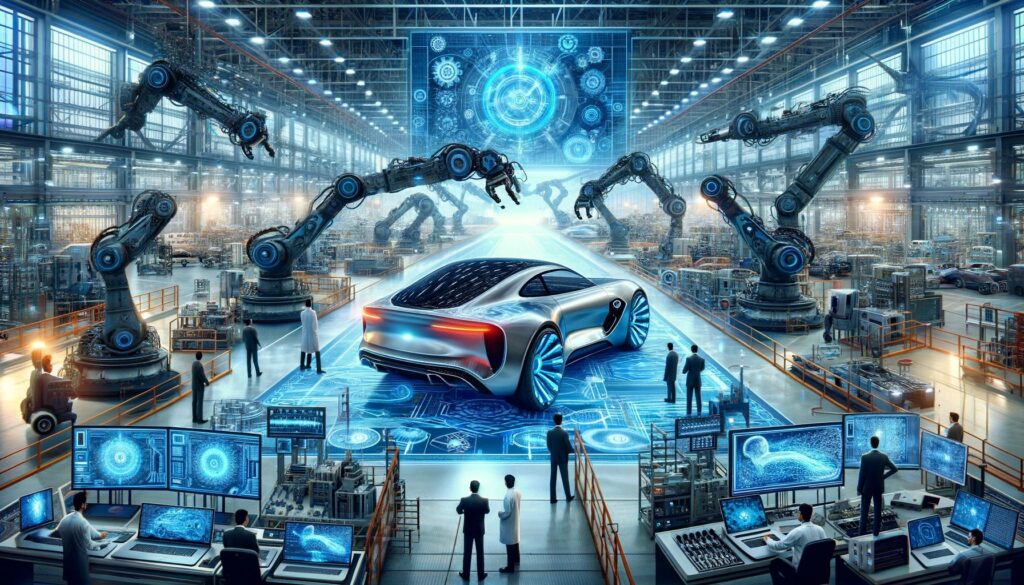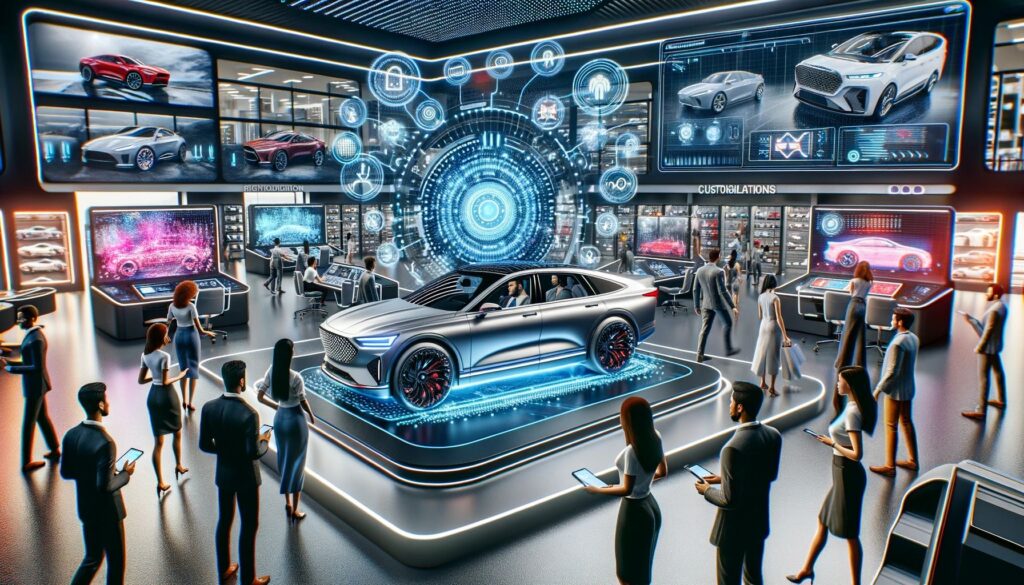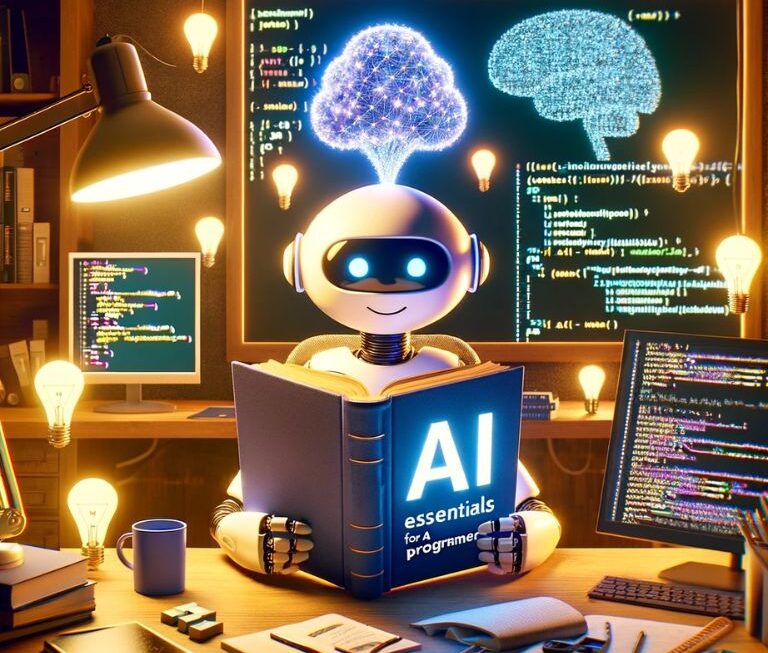In the ever-evolving landscape of automotive design and engineering, the integration of Artificial Intelligence (AI) has emerged as a game-changer. Generative AI, in particular, has revolutionized the way cars are conceived, designed, and manufactured. This section introduces the profound impact of generative AI in the automotive industry, shedding light on how this technology is propelling innovation in car models and features.
The Automotive Design Metamorphosis
Automotive design heavily relied on human creativity and expertise, a time-consuming and resource-intensive process with design limitations. The advent of generative AI, powered by machine learning algorithms, has transformed automotive design. This technology brings unparalleled efficiency, creativity, and adaptability to the field, ushering in a new era of possibilities in car design.
Traditional vs. AI-Infused Design
To appreciate the transformative power of generative AI in automotive design, it is crucial to understand the stark contrast between traditional and AI-infused methodologies:
| Aspect | Traditional Design | AI-Infused Design |
| Design Process | Iterative and time-consuming; reliant on human intuition | Accelerated, automated, and driven by data and algorithms |
| Creativity | Limited by human constraints and biases | Unlimited possibilities with AI’s creative pattern recognition |
| Resource Consumption | High costs associated with human labor and design tools | Cost-effective, reduced resource requirements |
| Iterations and Variability | Limited iterations due to time constraints | Rapid iteration and exploration of diverse design options |
| Design Exploration and Innovation | Incremental improvements over time | Radical innovations and exploration of unconventional ideas |
The shift from traditional design to AI-infused design is akin to moving from a hand-drawn map to a GPS navigation system. Generative AI serves as the compass guiding automotive designers toward uncharted territories of innovation.
The Evolution of Automotive Design
A Historical Perspective on Automotive Design
To truly grasp the impact of generative AI on automotive design, it’s essential to take a brief journey through the history of automotive aesthetics and engineering. The roots of automobile design can be traced back to the late 19th century when pioneers like Karl Benz and Henry Ford introduced the world to motorized vehicles. These early automobiles were rudimentary in design, with a primary focus on functionality rather than aesthetics.
As the automotive industry evolved, design became an integral aspect of car manufacturing. In the early to mid-20th century, iconic car models such as the Ford Model T and the Chevrolet Bel Air captured the public’s imagination with their distinct shapes and styles. These designs were predominantly crafted by human designers and engineers, often resulting in visually striking but mechanically limited vehicles.
How Traditional Methods Have Evolved to Incorporate AI-Driven Innovation
In the 21st century, automotive design integrates generative AI, resulting in:
- Efficiency: Rapid concept development, shortening design timelines.
- Data-Driven: AI uses data for precise design decisions.
- Creativity: AI encourages innovative and unconventional design elements.
- Cost-Effective: AI automation and reduced prototyping cut costs.
- Collaboration: Human-AI synergy enhances design, promoting a collaborative approach.
Generative AI in Car Model Creation

Exploring Generative AI’s Role in the Initial Design Phase
Generative AI transforms car model creation:
- Conceptual Design: AI generates diverse concepts, aligning with vision.
- Design Optimization: Algorithms enhance performance, safety, and aesthetics.
- Material Selection: AI considers weight, durability, and cost-effectiveness.
- Iterative Prototyping: Virtual prototypes speed up design refinement.
- User-Centric Design: AI incorporates user feedback for personalized cars.
Illustrating the Impact: Case Studies of AI-Generated Car Designs
To vividly illustrate the transformative power of generative AI in car model creation, let’s delve into a couple of real-world case studies:
Case Study 1: The Tesla Cybertruck
Tesla’s Cybertruck, unveiled in 2019, serves as a prime example of generative AI’s influence on automotive design. The Cybertruck’s distinctive angular design, featuring sharp lines and a futuristic aesthetic, was partly generated using AI algorithms. By optimizing the vehicle’s exterior for strength and aerodynamics, Tesla created a visually striking yet highly functional electric pickup truck.
Case Study 2: Toyota’s AI-Generated Car Design
Toyota, a pioneer in AI-driven design, collaborated with the Toyota Research Institute (TRI) to create an AI-generated concept car in 2020. The concept, known as the “LQ,” showcased a futuristic interior that adapts to the driver’s preferences and emotions. Generative AI played a pivotal role in crafting the LQ’s unique interior experience, which included interactive touchpoints, AI-driven personalization, and adaptive lighting.
Enhancing Safety and Performance
How AI Optimizes Vehicle Safety and Performance
Generative AI goes beyond aesthetics in the automotive industry, significantly impacting safety and performance. AI utilizes real-time data and predictive analytics to make split-second decisions, mitigating risks and preventing accidents. Its ability to react faster than humans is invaluable in critical situations. Moreover, AI doesn’t just boost speed; it enhances intelligence. By continuously analyzing and adjusting parameters, AI optimizes engine performance, fuel efficiency, and the overall driving experience, democratizing performance improvements for a wide range of vehicles.
Examples of AI-Driven Safety Features and Performance Improvements
AI innovations in automotive technology include:
- Adaptive Cruise Control: Sensors and cameras adjust speed and following distance, enhancing safety.
- Lane-Keeping Assist: Detects lane markings and prevents drifting, reducing accidents.
- Collision Avoidance Systems: Predict and prevent collisions, alerting or taking control if necessary.
- Performance Optimization: AI adjusts engine parameters for improved power and fuel efficiency.
- Predictive Maintenance: AI predicts component failures, enabling proactive maintenance.
- Enhanced Driver Assistance: Systems like Tesla’s Autopilot offer automated lane changes and cruise control.
- Dynamic Suspension Control: Real-time suspension adjustments enhance comfort and handling.
Customization and Personalization
How Generative AI Enables Personalized Automotive Experiences

Generative AI is not just transforming the design and performance of automobiles; it’s also revolutionizing the way vehicles are tailored to individual preferences. This section explores how generative AI is making customization and personalization key components of the automotive experience.
Generative AI, powered by machine learning algorithms, can analyze vast amounts of data, including user preferences and historical choices, to craft personalized driving experiences. It goes beyond mere aesthetic customization to offer a host of tailored features and functionalities.
Tailoring Car Features to Individual Preferences
Generative AI personalization in the automotive sector covers:
- Infotainment Systems: AI recommends music, optimizes routes for tailored in-car entertainment.
- Interior Ambiance: AI controls lighting, temperature, and seats for a personalized in-car experience.
- Driver Assistance: Personalized settings balance comfort and safety for driver assistance systems.
- Voice Recognition: AI-enhanced voice recognition accommodates individual voices and accents.
- Augmented Reality Displays: AI customizes AR displays for driver-specific information, enhancing the driving experience.
Sustainability and Efficiency
Analyzing AI’s Role in Designing Eco-Friendly and Fuel-Efficient Vehicles
The pursuit of sustainability and increased fuel efficiency in the automotive industry has never been more critical. Generative AI plays a significant role in this endeavor, reshaping the way vehicles are engineered to reduce their environmental impact.
AI-driven sustainability initiatives extend beyond electric vehicles (EVs). While EVs are an essential part of the solution, generative AI impacts every aspect of vehicle design and operation to enhance efficiency and sustainability.
Reducing the Carbon Footprint Through AI-Driven Engineering
Generative AI benefits in the automotive industry:
- Aerodynamic Optimization: Enhances efficiency and reduces fuel consumption through improved vehicle design.
- Weight Reduction: Identifies ways to make vehicles lighter without compromising safety, boosting fuel efficiency.
- Powertrain Efficiency: Optimizes powertrain components, reducing fuel consumption and emissions.
- EV Battery Management: Improves electric vehicle battery efficiency, extending range and lifespan.
- Predictive Maintenance & Eco-Materials: Predicts maintenance needs and aids in sustainable material selection for eco-friendly manufacturing and operation.
Challenges and Future Prospects
Addressing the Challenges and Ethical Considerations in AI-Driven Automotive Design
While the integration of generative AI in automotive design and engineering holds immense promise, it also presents a set of unique challenges and ethical considerations. In this section, we’ll delve into the hurdles that need to be overcome and the ethical questions that must be addressed.
Challenges in AI-Driven Automotive Design
- Data Privacy: Collecting and utilizing vast amounts of data for AI training raises concerns about privacy and data security. Ensuring the protection of user data is paramount.
- Regulatory Compliance: As AI becomes increasingly integral to vehicle design, regulators must establish clear guidelines to ensure safety, fairness, and ethical usage.
- Ethical AI Decisions: AI systems making split-second decisions, especially in autonomous vehicles, need to be programmed with ethical principles to prioritize human safety and well-being.
- Reliability and Safety: Ensuring that AI systems are robust and safe under various conditions, including extreme weather and road situations, is a significant challenge.
- Human-AI Collaboration: Defining the roles and responsibilities of human designers and AI algorithms in the design process is crucial for productive collaboration.
Ethical Considerations
- Autonomous Vehicle Ethics: Who is responsible in the event of an accident involving an autonomous vehicle? Addressing the ethical implications of AI-driven decision-making is a critical aspect.
- Bias and Fairness: AI models can inadvertently perpetuate biases present in training data. Efforts to mitigate bias and ensure fairness are essential.
- Transparency: Ensuring transparency in AI decision-making processes is vital for building trust among users and regulators.
Predicting the Future of Generative AI in the Automotive Industry
The future of generative AI in the automotive industry is exceptionally promising. As technology continues to advance, we can anticipate several key developments:
- Enhanced Safety: AI-driven safety systems will become even more sophisticated, significantly reducing the number of accidents on the road.
- Personalized Mobility: Generative AI will offer personalized mobility solutions, from custom-designed vehicles to tailored in-car experiences.
- Sustainability: The automotive industry will continue its transition to eco-friendly vehicles, with AI playing a central role in optimizing efficiency and reducing emissions.
- Autonomous Driving: Fully autonomous vehicles will become more commonplace, reshaping the future of transportation and urban planning.
- Innovative Designs: AI will continue to push the boundaries of automotive design, resulting in vehicles that are both aesthetically pleasing and highly functional.
- Advanced AI Ethical Frameworks: Ethical considerations and frameworks for AI in the automotive sector will evolve, addressing the complexities of AI-driven decision-making.
- Human-Machine Interaction: AI will improve the way humans interact with vehicles, making driving safer and more intuitive.
Conclusion
Generative AI’s integration into automotive design marks a transformative era of innovation. It reshapes car models, enhances safety, personalization, and sustainability. While the journey poses challenges and ethical considerations, responsible navigation ensures safe and ethically sound AI-driven automotive design. The future promises efficient, eco-friendly vehicles tailored to individual preferences. Fully autonomous vehicles and evolving AI-driven principles redefine mobility. With ethical stewardship, the automotive industry aims to create vehicles that showcase human ingenuity and technological prowess, transcending mere transportation.




